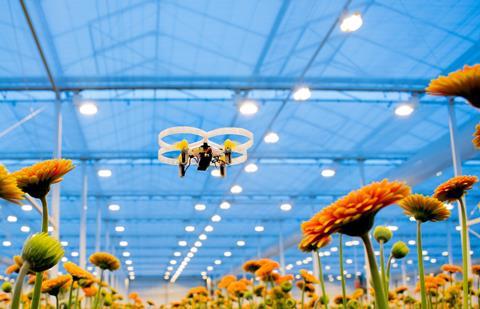
Flying insects that threaten to damage valuable crops may soon have another think coming in the form of automated, 'bat-like' drones programmed to mimic their flight patterns and eliminate them.
Following a small-scale trial at a flower nursery in the Dutch province of South Holland last year, a new research project due to take off this month will look at how the deployment of small drones can automate insect control and prevention.
According to those involved, the use of drones to protect production of fruit, vegetables and flowers could eventually contribute to greater sustainability in commercial horticulture, by reducing the need for chemical or organic insecticides and limiting the amount of time and money spent on monitoring their application.
The ten-week trial is set to be piloted by PATS Indoor Drone Solutions – a spin-off of the Delft University of Technology – and has the backing of several Dutch growers.
It will focus on the control of Golden twin-spot moth at a test greenhouse planted with gerberas at the world-renowned innovation centre Demokwekerij Westland in Naaldwijk.
“The objective of the pilot is not only to measure effectiveness, but also to improve technology. The drones are taught specific flight behaviour similar to the agile flight behavior of this moth,” explains PATS' Sjoerd Tijmons.
Kevin van Hecke, co-founder of PATS and a drone researcher at TU Delft, adds: 'You can best compare our drones with bats, a natural enemy of flying insects.'
Taking off
In the summer of 2018, PATS organised a small trial at Holstein Flowers, a Gerbera nursery in De Lier, The Netherlands.
Early results were apparently positive, prompting other growers to register their interest.
'There are currently insufficient effective means available to combat adult flying insects,' suggests Jeroen Sanders, researcher at Demokwekerij Westland. 'That is why this technology is a good addition to a holistic approach.'
The technology is seen not merely as an add-on to existing control solutions, rather PATS believes drones will also reduce the need for other forms of pest control.
Co-founder Bram Tijmons insists the goal is for the system to control the problematic moth population in its entirety.
'It will act as a targeted and preventive approach,' he comments. 'In the next few years we will be adding support for different types of flying insects as well.”
Should the pilot prove successful, those involved intend to scale up the tests to a larger greenhouse towards the final quarter of the year.



